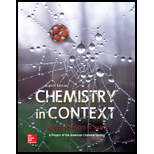
Chemistry in Context
8th Edition
ISBN: 9780073522975
Author: American Chemical Society
Publisher: McGraw-Hill Education
expand_more
expand_more
format_list_bulleted
Question
Chapter 7, Problem 46Q
Interpretation Introduction
Interpretation:
The decommission term used in nuclear field has to be explained and also the technical challenges involved in that has to be given.
Expert Solution & Answer
Want to see the full answer?
Check out a sample textbook solution
Students have asked these similar questions
Calculate the pH and the pOH of each of the following solutions at 25 °C for which the substances ionize completely:
(a) 0.200 M HCl
Calculate the pH and the pOH of each of the following solutions at 25 °C for which the substances ionize completely:
(a) 0.000259 M HClO4
What is the pH of a 1.0 L buffer made with 0.300 mol of HF (Ka = 6.8 × 10⁻⁴) and 0.200 mol of NaF to which 0.160 mol of NaOH were added?
Chapter 7 Solutions
Chemistry in Context
Ch. 7.1 - This map shows the 31 states with nuclear power...Ch. 7.1 - Prob. 7.4CTCh. 7.2 - Prob. 7.5YTCh. 7.2 - Prob. 7.7YTCh. 7.3 - Prob. 7.8YTCh. 7.3 - Prob. 7.9YTCh. 7.3 - Prob. 7.10YTCh. 7.3 - Prob. 7.11CTCh. 7.5 - Equation 6.10 represents the combustion of...Ch. 7.5 - Prob. 7.16CT
Ch. 7.6 - Prob. 7.17CTCh. 7.6 - Prob. 7.21YTCh. 7.6 - Prob. 7.22CTCh. 7.7 - Prob. 7.23YTCh. 7.7 - Prob. 7.24CTCh. 7.8 - Prob. 7.25YTCh. 7.8 - Prob. 7.26YTCh. 7.8 - Prob. 7.27YTCh. 7.8 - Prob. 7.28YTCh. 7.8 - Prob. 7.29SCCh. 7.10 - Prob. 7.32CTCh. 7.10 - Prob. 7.33SCCh. 7.11 - Prob. 7.34CTCh. 7.11 - Prob. 7.35CTCh. 7 - Prob. 7.1CTCh. 7 - Name two ways in which one carbon atom can differ...Ch. 7 - Prob. 2QCh. 7 - a. How many protons are in the nucleus of this...Ch. 7 - Prob. 4QCh. 7 - Prob. 5QCh. 7 - Prob. 6QCh. 7 - Prob. 7QCh. 7 - Prob. 8QCh. 7 - Prob. 9QCh. 7 - Prob. 10QCh. 7 - Prob. 11QCh. 7 - Prob. 12QCh. 7 - Prob. 13QCh. 7 - Prob. 14QCh. 7 - Prob. 15QCh. 7 - Prob. 16QCh. 7 - Prob. 17QCh. 7 - Prob. 18QCh. 7 - Prob. 19QCh. 7 - Prob. 20QCh. 7 - Prob. 21QCh. 7 - Prob. 22QCh. 7 - Prob. 23QCh. 7 - Prob. 24QCh. 7 - Prob. 25QCh. 7 - Prob. 26QCh. 7 - Prob. 27QCh. 7 - Prob. 28QCh. 7 - Prob. 29QCh. 7 - Prob. 30QCh. 7 - Prob. 31QCh. 7 - Prob. 32QCh. 7 - Prob. 33QCh. 7 - Prob. 34QCh. 7 - Prob. 35QCh. 7 - Prob. 36QCh. 7 - Prob. 37QCh. 7 - Prob. 38QCh. 7 - Prob. 39QCh. 7 - Prob. 40QCh. 7 - Prob. 41QCh. 7 - Prob. 42QCh. 7 - Prob. 43QCh. 7 - Prob. 45QCh. 7 - Prob. 46QCh. 7 - Prob. 47QCh. 7 - Prob. 48QCh. 7 - Prob. 49QCh. 7 - Prob. 50QCh. 7 - Prob. 51QCh. 7 - Prob. 52QCh. 7 - Prob. 53QCh. 7 - Prob. 54QCh. 7 - Prob. 55QCh. 7 - Prob. 56QCh. 7 - Prob. 57QCh. 7 - Prob. 58Q
Knowledge Booster
Similar questions
- Determine if the following salt is neutral, acidic or basic. If acidic or basic, write the appropriate equilibrium equation for the acid or base that exists when the salt is dissolved in aqueous solution. If neutral, simply write only NR. Be sure to include the proper phases for all species within the reaction. NaN₃arrow_forwardCan I please get help with this?arrow_forwardCan I please get help with this?arrow_forward
- Use the Henderson-Hasselbalch equation to calculate pH of a buffer containing 0.050M benzoic acidand 0.150M sodium benzoate. The Ka of benzoic acid is 6.5 x 10-5arrow_forwardA. Draw the structure of each of the following alcohols. Then draw and name the product you would expect to produce by the oxidation of each. a. 4-Methyl-2-heptanol b. 3,4-Dimethyl-1-pentanol c. 4-Ethyl-2-heptanol d. 5,7-Dichloro-3-heptanolarrow_forwardWhat is the pH of a 1.0 L buffer made with 0.300 mol of HF (Ka = 6.8 × 10⁻⁴) and 0.200 mol of NaF to which 0.160 mol of NaOH were added?arrow_forward
- Can I please get help with this.arrow_forwardDetermine if the following salt is neutral, acidic or basic. If acidic or basic, write the appropriate equilibrium equation for the acid or base that exists when the salt is dissolved in aqueous solution. If neutral, simply write only NR. Be sure to include the proper phases for all species within the reaction. N₂H₅ClO₄arrow_forwardPlease help me with identifying these.arrow_forward
arrow_back_ios
SEE MORE QUESTIONS
arrow_forward_ios
Recommended textbooks for you
 Chemistry for Engineering StudentsChemistryISBN:9781285199023Author:Lawrence S. Brown, Tom HolmePublisher:Cengage Learning
Chemistry for Engineering StudentsChemistryISBN:9781285199023Author:Lawrence S. Brown, Tom HolmePublisher:Cengage Learning Chemistry & Chemical ReactivityChemistryISBN:9781337399074Author:John C. Kotz, Paul M. Treichel, John Townsend, David TreichelPublisher:Cengage Learning
Chemistry & Chemical ReactivityChemistryISBN:9781337399074Author:John C. Kotz, Paul M. Treichel, John Townsend, David TreichelPublisher:Cengage Learning Chemistry for Engineering StudentsChemistryISBN:9781337398909Author:Lawrence S. Brown, Tom HolmePublisher:Cengage Learning
Chemistry for Engineering StudentsChemistryISBN:9781337398909Author:Lawrence S. Brown, Tom HolmePublisher:Cengage Learning Chemistry: The Molecular ScienceChemistryISBN:9781285199047Author:John W. Moore, Conrad L. StanitskiPublisher:Cengage Learning
Chemistry: The Molecular ScienceChemistryISBN:9781285199047Author:John W. Moore, Conrad L. StanitskiPublisher:Cengage Learning Living By Chemistry: First Edition TextbookChemistryISBN:9781559539418Author:Angelica StacyPublisher:MAC HIGHER
Living By Chemistry: First Edition TextbookChemistryISBN:9781559539418Author:Angelica StacyPublisher:MAC HIGHER Chemistry: Principles and PracticeChemistryISBN:9780534420123Author:Daniel L. Reger, Scott R. Goode, David W. Ball, Edward MercerPublisher:Cengage Learning
Chemistry: Principles and PracticeChemistryISBN:9780534420123Author:Daniel L. Reger, Scott R. Goode, David W. Ball, Edward MercerPublisher:Cengage Learning

Chemistry for Engineering Students
Chemistry
ISBN:9781285199023
Author:Lawrence S. Brown, Tom Holme
Publisher:Cengage Learning

Chemistry & Chemical Reactivity
Chemistry
ISBN:9781337399074
Author:John C. Kotz, Paul M. Treichel, John Townsend, David Treichel
Publisher:Cengage Learning

Chemistry for Engineering Students
Chemistry
ISBN:9781337398909
Author:Lawrence S. Brown, Tom Holme
Publisher:Cengage Learning

Chemistry: The Molecular Science
Chemistry
ISBN:9781285199047
Author:John W. Moore, Conrad L. Stanitski
Publisher:Cengage Learning

Living By Chemistry: First Edition Textbook
Chemistry
ISBN:9781559539418
Author:Angelica Stacy
Publisher:MAC HIGHER

Chemistry: Principles and Practice
Chemistry
ISBN:9780534420123
Author:Daniel L. Reger, Scott R. Goode, David W. Ball, Edward Mercer
Publisher:Cengage Learning